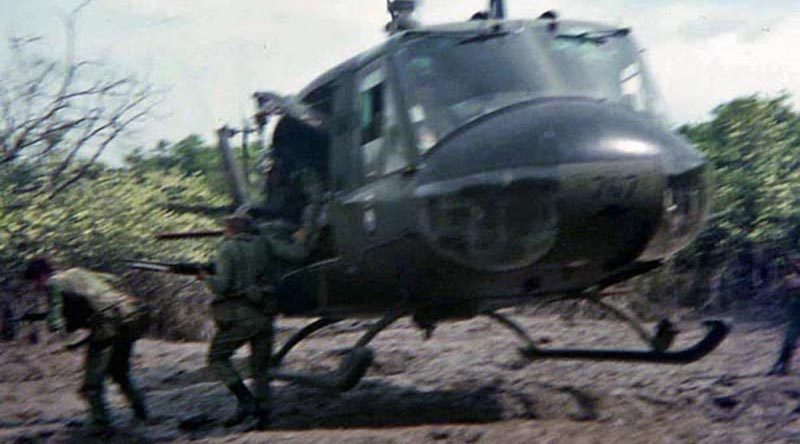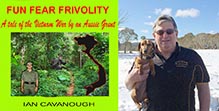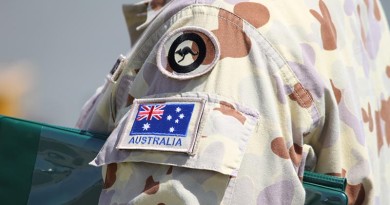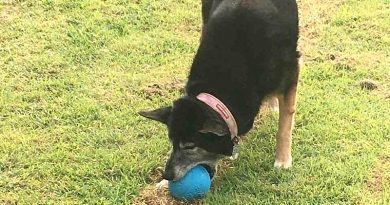Chapter 40: The Rung Sat

“What the hell is the Rung Sat?” I hear you ask. Well it is a mangrove swamp, known as ‘The Delta’ It covered a huge area from Vung Tau to Saigon. Our sojourn was limited to the swamps just south of the village of Phu My – and we still hadn’t had a chance to visit the pub there.
The Viet Cong were using the Rung Sat extensively and the Americans had a whole ‘Riverine Force’ which conducted operations in launches and extremely quick patrol boats in the larger estuaries. I never saw one so I can’t tell you much about them.
Our platoon effort was not that sophisticated, we patrolled on foot. It wasn’t always like that. B Company did some patrolling in boats with outboard motors with limited success.
Our objective was to find a hospital staging area where the VC brought in their wounded. I should mention that the CO, Johnny Three Fingers was shot down in the Rung Sat not far from where a bunch of Kiwis were conducting operations, not that I am suggesting the Kiwis had anything to do with it of course, cough, cough.
We went in by chopper. They found a small clearing in the mangrove swamp and hovered about a foot off the ground and we jumped out into the mud. The photo above shows Killer gingerly stepping off the chopper. A couple of steps later he was knee deep in mud. I was laughing so much I didn’t capture the moment on film as I had packed my camera away already. Things happen like that during war, don’t they?
We were travelling light as our packs were back at the Fire Support Base (FSB) it would be bloody impossible to negotiate the mangrove swamps in full battle gear.
It was hard going in the swamp. The mud sucked on your boot each time you went to pull it out and take a step forward. I found it easier to step where others had, they churned the mud up somewhat making it quite slushy; it was slippery but the effort was easier without the suction. Another way was to step on the mangrove roots but only the thin ones. The thick ones didn’t give way and your boot slipped off them making you stumble. The last thing you want to do in the swamps is to come a gutsa – your mates would never let you live it down and beside I couldn’t stand them laughing at me all covered in slimy, sticky, stinking mud. We made a bloody great track through the mangrove swamps. I hated every step.
We did this for two days and found nothing. Each afternoon we were winched out and we camped overnight at the FSB. There was no vegetation around us and at about 4am one night I got up for a leak. I looked towards the southern sky and there was the Southern Cross way down low near the horizon. I was so excited I woke up Mick, the platoon sergeant: “Mick, Mick. Look, there’s the bloody Southern Cross.”
He mumbled something “What, oh yeah, OK Knackers.”
Later that morning when I mentioned it to him – he didn’t believe me. I don’t think I dreamt it.
Things got a lot better on our third day in the swamp. We were patrolling again in single file, slipping and sliding everywhere. Then a strange thing happened; the mangroves seemed to open up. They thinned out. The canopy was still the same but the mangrove trees seemed less dense, we could see about 50 metres in front of us rather than the usual 10 metres. Things were looking up. In addition there were marks on the mangrove trees – little shiny bits where things were rubbing up against the branches. Sum Wun suggested that canoes may be responsible for the marks as Nigel floated his wounded colleagues in the tide.
We could sense we were getting closer to our objective. The platoon was definitely switched on at this stage.
We came across an eggcup! It was a structure made out of mud and styled just like an eggcup. It was big enough for a VC to occupy. Our guess was it was a sentry position where the sentry could remain dry when the tide came in. Unfortunately it looked old and had not been used recently. Encouraged though, we patrolled on. We were REALLY switched on now.
We came across two odd structures. They looked like igloos made out of mud, beside each of them was a square shaped pool of water. Inside each igloo was a tunnel that could house two men. The mangroves were growing out of the top of the igloo so it would be impossible to see from above. The mud to construct these structures was obviously dug from the nearby holes which were now filled with water. They had no recent use. What impressed me though, apart from Nigel’s ingenuity, was how square the hole was.
Suddenly we burst into an occupied camp. There was a fire and other evidence of habitation by a large number of enemy; and there were a lot of footprints leading away from the camp. Moon decided to chase them up, I stayed behind in the enemy camp with him and Mick the platoon sergeant took some of the boys and followed the footprints. Moon asked for assistance in the form of artillery or helicopter gunships to cut off the fleeing enemy. This was denied – something about the Geneva Convention – we were in a hospital staging area – there would be no artillery or helicopter gunship support.
The CO’s chopper came out for a recce. The pilot reported that there were about 30 enemy in front of our guys. It was an impossible situation. There was no way our guys would catch them in these muddy conditions so the chase was called off and they all got away.
I was talking to Digger about these enemy guys – their little bare footprints were everywhere. You could tell they were running, their toes were splayed out and mud was pushed up between them. When I mentioned to Digger that the pilot reckons there were about 30 enemy ahead of them he said they knew from the tracks that there were a lot of VC, but they nearly shit themselves when they found out the actual number as there were only ten blokes with him. It could have got quite nasty.
We regrouped back at the enemy camp. Moon decided we would stay there for the night just in case they returned, I was very apprehensive about this. We were going to stay for a night in an enemy camp and not only was there a danger of the enemy returning to take us on (there were 23 of us) and there was also the danger of mines and booby traps.
The camp was very well designed. There were quite a few of these igloos in roughly a semi circle. Inside each was a tunnel-like shape with two stretchers made out of small twigs and cuttings so that Nigel would be off the mud.
Each igloo was linked by a series of poles. These were set on an ‘X’ type frame putting the poles about a foot off the ground. They were not high enough to escape the high tide mark but by walking along them Nigel was clear of the mud.
There were a number of tables and seats, just like picnic tables we have in our parks. These were also made from sticks and tied together.
In the open part of the semi circle was a fire and a large basket type arrangement that was lined with plastic and filled with fresh water. It was also set above the high tide mark. There were a few mud crabs tied up and stored in another basket.
I tried to take some photos of the camp with my little instamatic camera but it was too dark and the slides came out so black that it was hard to make anything out. But I’ll give it to these VC, old Nigel was an ingenious bastard that’s for sure.
The chopper came and threw our packs out from a height of a two storey building. My pack survived OK, the only thing damaged was a spare battery that split open and was cactus.
We were issued with hammocks. These were the inner liner of the sleeping bag made out of silk. They were sewn up and an open hem was sewn in on each end. We could push a stick through the hem and tie it to the tree or simply thread our toggle ropes through and tie it off to a tree. I found it was better to push a stick through each end and tie them off. I had never slept in a hammock before and I had no idea how high the tide would rise. I simply tied the hammock as high as I could. The mangrove trees are not that strong and the branches bent easily under my weight.
I climbed in and the branches didn’t break off. I hung everything up in the trees: the radio, now with my pack attached, and my boots – I hated sleeping with my boots on. I didn’t get much sleep as there was a fair bit of noise when the tide came in. As the water filled all the little holes in the soil it made bleep, bleep, bleep noises and the tide rose up closer to my backside. I put my hand out and the water was just four inches from my backside, I thought I was in for a wet night but that was the limit to the tide.
I was woken a few times by blokes moving about in the water, I dunno what they were doing, maybe they attempted to sleep on the ground and were hastily erecting their hammocks when the tide came in. Surely they were not that dumb – oh I forgot, there were a few dumb guys in 6 section.
As daylight filtered in I surveyed the area. No one was up walking around. Those that I could see were in hammocks, high and dry like me. No one was game enough to sleep inside the igloos as the couple I could see were empty; and then I saw Moon. He decided to sleep on the picnic table, half of it gave way and his feet were in the water; he was sound asleep. I gave a chuckle to myself and cursed that I couldn’t get a decent photo.
Soon we were up and sloshing about the water. A few blokes tried to walk on the poles but the boots just slipped off. We sent a clearing patrol out to have a look around. The enemy did indeed return some time during the night – maybe that’s what I heard, I’m not sure. They didn’t come into our, or rather their, camp though, but they dug something up out of the pools where the old igloos were.
Word came down from the OC A Company that the camp was to be destroyed and a couple of hours later some engineers turned up with lots of explosive stuff to blow this place to comedom king. We looked for a clearing so the choppers could hover low for them to jump out like we did but in the end they were winched down to us.
Boy did they blow the place.
And then they winched us out.
I was one of the last ones to be winched up and the chopper floor was covered in mud.
Back at the FSB we borrowed some stuff from the tankies and cooked up a feed of crabs, courtesy of Nigel.
Whilst the other companies swanned around the Rung Sat in boats, staying nice and dry, they found nothing.
It was 2 Platoon that located the hospital staging area – probably by sheer chance – but we didn’t care – we were feeling really confident about taking the fight up to Nigel even though we only numbered 23.
.
.
Reproduced with permission from FUN, FEAR, FRIVOLITY – A tale by an Aussie infantry soldier in the Vietnam War – which is now also available in ebook format. See here to order.
..
.
Hi guys. I am a good-looking, opinionated old fart who relishes a spirited debate on any topic regardless of how much I think I know about it.
Ian Cavanough,
Tumut, NSW
.
.
.
..
.
.

.
.







This has been a great story and bought back memories of my two tours; 65-66 and 1970.
When you spoke of the hammocks; they were made from using the Lilo mattress, without the tubes. They were stitched in such a way as to allow the positioning of a pole along each side.
Hi Maurie
We used the mattress cover to make hammocks when at the Land Clearing Teams, but in the Rung Sat we had ones made outa the silk.
Keep reading Maurie because I soon win the war, single handed of course.
Cheers
Cav